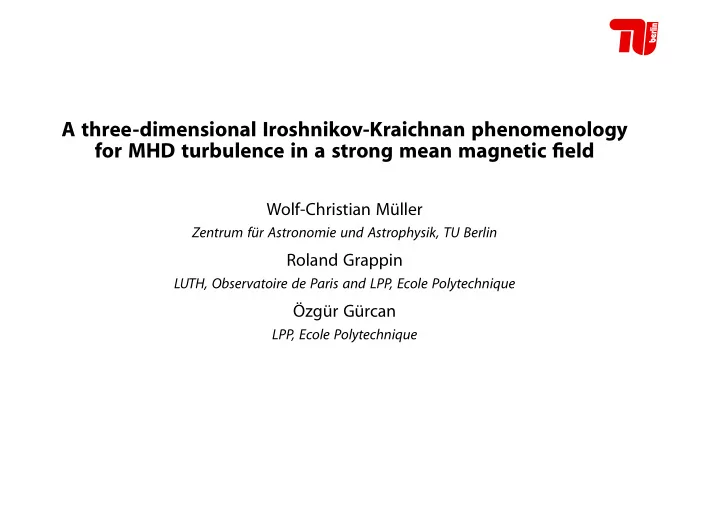

A three-dimensional Iroshnikov-Kraichnan phenomenology for MHD turbulence in a strong mean magnetic field Wolf-Christian Müller Zentrum für Astronomie und Astrophysik, TU Berlin Roland Grappin LUTH, Observatoire de Paris and LPP, Ecole Polytechnique Özgür Gürcan LPP, Ecole Polytechnique
Turbulence in Mean Magnetic Fields Presumably different turbulent regimes → constraints on - timescales τ ac � , τ ac ⊥ (nonlinear time τ NL = ( k ⊥ b ⊥ ) − 1 , Alfvén time τ A = ( k � B 0 ) − 1 ) - Fourier space structure of turbulent excitations/driving Established phenomenologies ◮ Strong regime ( τ NL ∼ τ A ): Goldreich-Sridhar (3D, k − 5 / 3 ), Boldyrev (3D, k − 3 / 2 , ?) ⊥ ⊥ ◮ Weak regime ( τ NL ≫ τ A , k ⊥ ≫ k � ): e.g. Galtier, Ng & Bhattacharjee (3D, k − 2 ⊥ ) ◮ Iroshnikov-Kraichnan (2D, k − 3 / 2 ), weak turbulence variant, dwells only in 2D
Universality E 3 ( k, θ ) = A ( θ ) k − m − 2 = A 0 ( k/k d ) − m − 2 , A ( θ ) ≃ k d ( θ ) m +2
Fourier Energy Distribution ( k � - k ⊥ plane) Left: Critical balance cone (local frame): k � ∼ k 2 / 3 ⊥ Middle: CB cone subject to fluctuations around mean direction ∼ b ⊥ B 0 ≃ 1 5 Right: DNS with isotropic large-scale driving Extent along k � -axis apparently not explicable by reference-frame mapping
A Different Regime of MHD turbulence ◮ No standard weak Alfvén turbulence (no nonlinear transfer in parallel direction) ◮ No standard critically balanced turbulence (geometrically too restricted) ◮ Suspected reason: isotropic large-scale driving ◮ Possibility of extension of IK picture to three-dimensionality
General Nonlinear Triad Interaction q p k B o Convolution constraint on three-mode interactions: k = p + q Example: finite q � allows nonlinear field-parallel transfer
Resonant Nonlinear Triad Interaction q p k B o Convolution constraint on three-mode interactions: k = p + q Weak turbulence Resonance condition: ω ( k ) = ω ( p ) + ω ( q ) Alfvén waves: ω ( k ) = k · B 0 = k � B 0 Resonance condition implies q � = 0 , i.e. no field-parallel cascade Phase-mixing along B 0 prevents structure formation perpendicular to B 0
Causality Generalization of GS-critical balance: τ ac ⊥ ∼ τ ac � ∼ τ A Incompressible MHD ( B 0 � 2 − 3 ): τ NL ⊥ ∼ τ A If transfer in planes perpendicular to B 0 governed by IK cascade: ◮ τ ac ⊥ ∼ τ A ⊥ = ( k ⊥ b rms ⊥ ) − 1 ◮ τ A < τ A ⊥ < τ NL Relaxation of weak turbulence constraint ( τ A ≪ τ NL ) b rms ⊥ → possibility of quasi-resonant cascade , allows small q � ∼ q ⊥ B 0
Ricochet Process Realizes energy flow along directions oblique w.r.t. B 0 k_per k5 k3 q5 q4 k1 q2 q3 q1 k_par k4 k2 k6 Process based on two basic triads to transfer prolongations along two directions in Fourier space within region allowed by the quasi-resonance criterion. Dependent on dominant perpendicular cascade process populating excitations wi- thin the CB region. Start near Fourier origin requires externally excited fluctuations (e.g. isotropic large- scale forcing)
Nonlinear Energy Flux Isotropic K41 flux: ( k − 5 / 3 ) F K41 ∼ kv 3 k Iroshnikov-Kraichnan flux: ( k − 3 / 2 ) F IK ∼ kb 2 k b 2 q /B 0 F IK approximately reduced by factor b q B 0 comparison with quasi-resonant flux (triad counting) Ensemble of triads reduced through quasi-resonance constraint by factor b rms B 0
Dissipative Regions Estimating end of inertial range: τ diss ∼ τ flux diss ∼ νk 2 , τ flux � ∼ ku 2 b rms , τ flux ⊥ ∼ ku 2 τ − 1 B 0 (IK) k k k d � ∼ b rms k d ⊥ B 0 Found in numerical simulations (Grappin & Müller 2010)
Summary ◮ DNS of MHD turbulence with strong mean magnetic field, large-scale isotropic driving incompatible with standard theory ◮ Proposition of new cascade mechanism based on weak IK cascade if turbulent excitations outside critical balance region ◮ Ricochet mechanism allows for parallel and oblique nonlinear transport ◮ Three-dimensional extension of Iroshnikov-Kraichnan regime
Recommend
More recommend